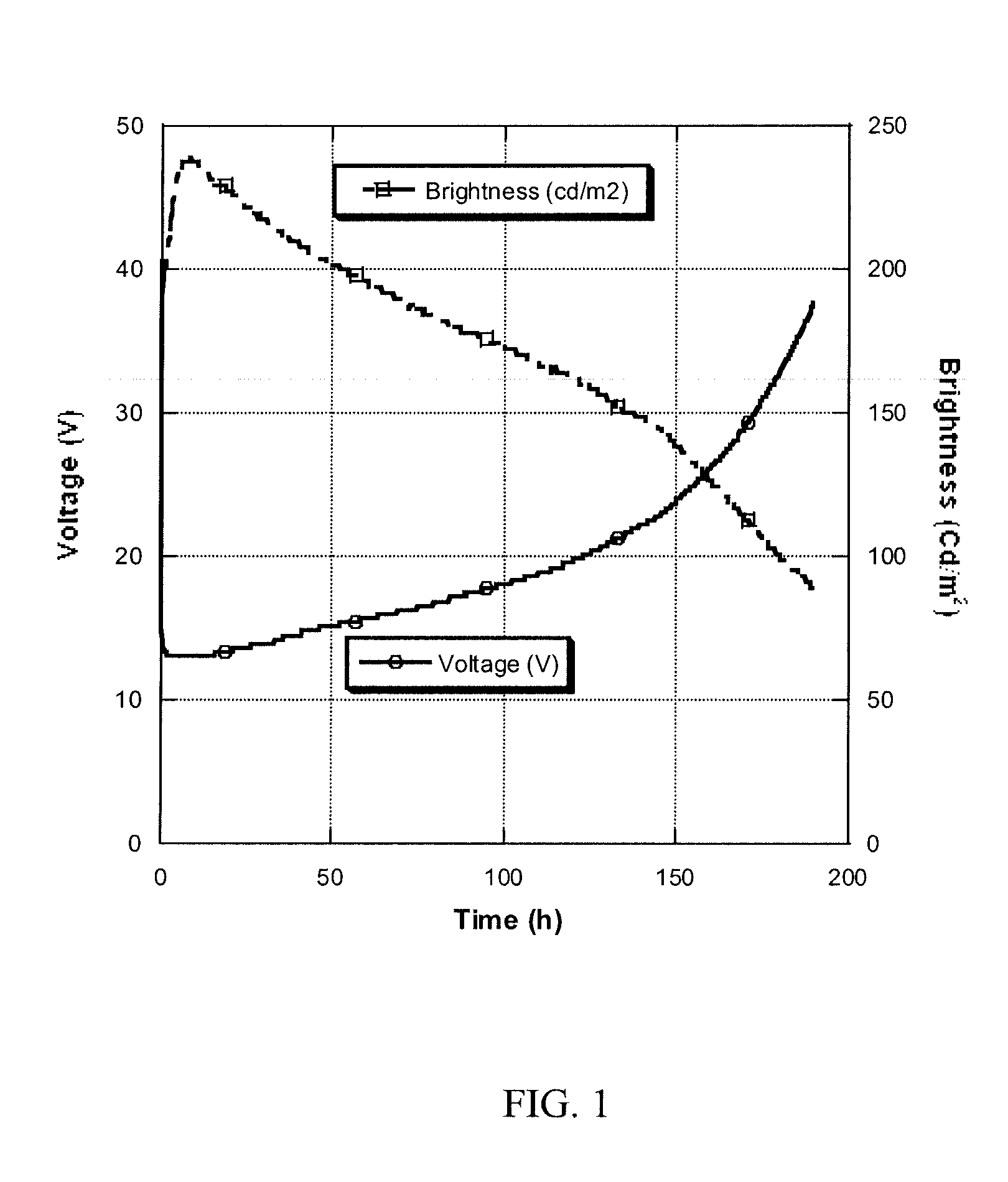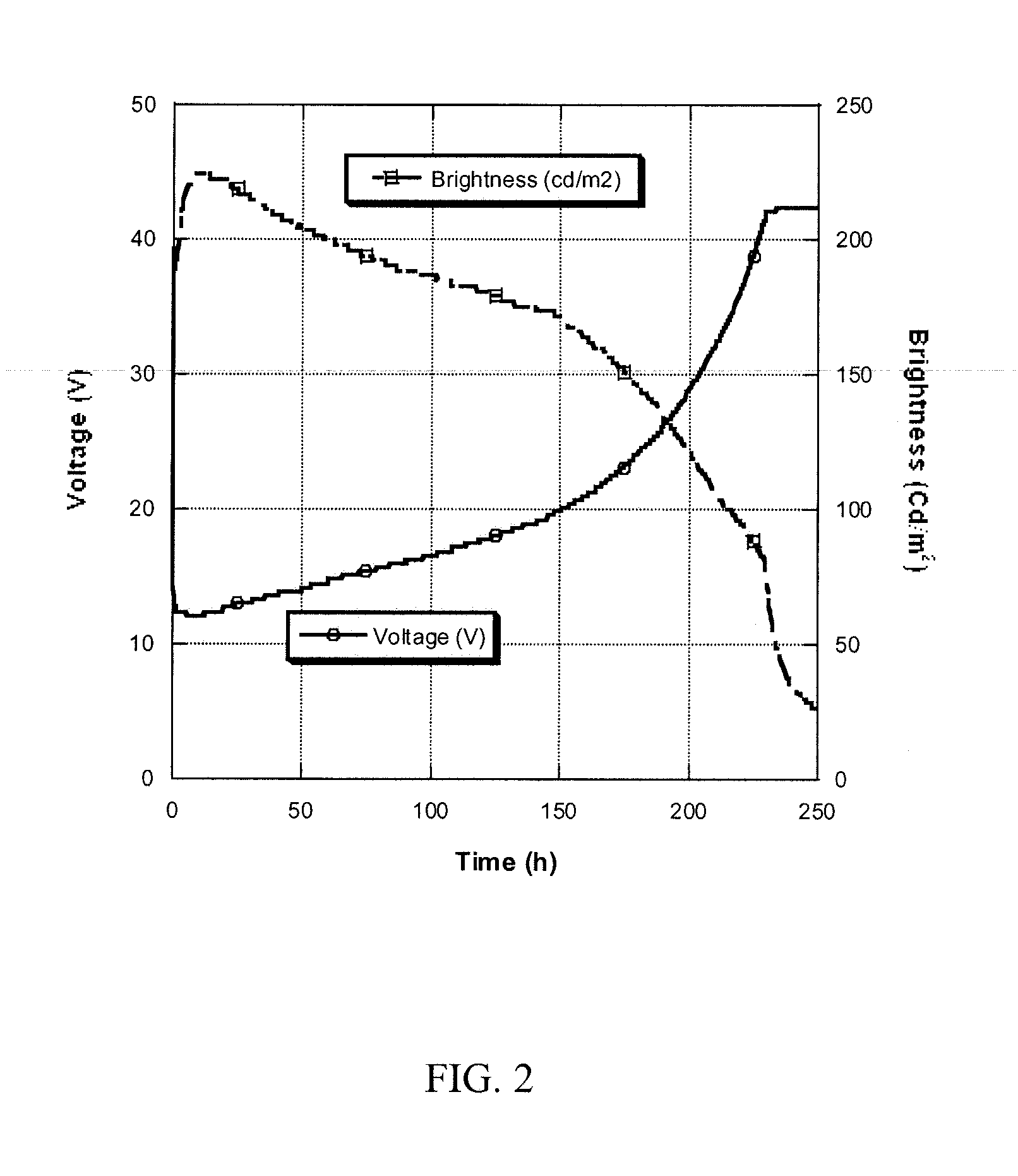Organic additives for improved lifetimes in organic and solution processible electronic devices
- Summary
- Abstract
- Description
- Claims
- Application Information
AI Technical Summary
Benefits of technology
Problems solved by technology
Method used
Image
Examples
example 1
[0042]In a glove box filled with nitrogen, a polyphenylene vinylene (PPV) polymer Yellow PDY132 (37 mg, Mw 1 million, Merck), polyethyleneoxide (PEO) (6 mg, Mw 600,000, Dow), and salts of tetra-n-hexylammonium hexafluorophosphate (1.70 mg, THAPF6), tetra-n-butylammonium hexafluorophosphate (0.62 mg, TBAPF6), and tribenzyl-n-octylammonium hexafluorophosphate (0.45 mg, BzOAPF6) were mixed together in solvents of chlorobenzene (2.5 g) and m-xylene (2.5 g). After thoroughly mixing, the ink was transferred out from the glove box and screen-printed onto a pre-patterned indium tin oxide (ITO)-coated polyethylene terephthalate (PET) substrate with an active area of 1 cm2. After removing the solvents by heating the substrate, 600 nm LEP film was obtained on PET substrate. The top electrode Ag from silver paste was subsequently printed onto the luminescent polymer layer, to complete the device fabrication. The device was then transferred into a nitrogen glove box and tested under a constant c...
example 2
[0043]This ink was formulated in a similar way as described above for Example 1, but adding an additional 6 mg of 3-butyl-2-(1-ethylpentyl)oxazolidine (BEOXa, Scheme 1). BEOxa is very soluble in chlorobene / m-Xylene mixed solvents and is also compatible to LEP polymers. It is believed that BEOXa will be hydrolyzed to open the oxazolidine ring and to form the ketone-alcohol product when heated during both LEP and Ag annealing processes. Removing water in devices definitely improves PLEC lifetime as shown below in FIG. 2. It has a brightness lifetime (100 cd / m2) of 900 h when 1.8 power factor is used (FIG. 2).
LEP Ink Mixed with Antioxidant
example 3
[0044]This ink was formulated in a similar way as described above for Example 1, by adding additional 6 mg 2,2′-ethylidene-bis(4,6-di-tert-butylphenol) (EBP, Scheme 2). It has a brightness lifetime (100 cd / m2) of 800 h when 1.8 power factor is used (FIG. 3). This antioxidant EBP did not help improve device lifetime, suggesting that its compatibility with LEP was poor and its reactivity with oxidant was ineffective.
PUM
 Login to View More
Login to View More Abstract
Description
Claims
Application Information
 Login to View More
Login to View More - R&D
- Intellectual Property
- Life Sciences
- Materials
- Tech Scout
- Unparalleled Data Quality
- Higher Quality Content
- 60% Fewer Hallucinations
Browse by: Latest US Patents, China's latest patents, Technical Efficacy Thesaurus, Application Domain, Technology Topic, Popular Technical Reports.
© 2025 PatSnap. All rights reserved.Legal|Privacy policy|Modern Slavery Act Transparency Statement|Sitemap|About US| Contact US: help@patsnap.com



